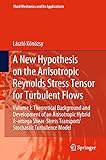A New Hypothesis on the Anisotropic Reynolds Stress Tensor for Turbulent Flows [electronic resource] : Volume I: Theoretical Background and Development of an Anisotropic Hybrid k-omega Shear-Stress Transport/Stochastic Turbulence Model / by László Könözsy.
By: Könözsy, László [author.] .
.
Contributor(s): SpringerLink (Online service) .
.
Material type:  BookSeries: Fluid Mechanics and Its Applications: 120Publisher: Cham : Springer International Publishing : Imprint: Springer, 2019Edition: 1st ed. 2019.Description: XVII, 141 p. 5 illus., 4 illus. in color. online resource.Content type: text Media type: computer Carrier type: online resourceISBN: 9783030135430.Subject(s): Fluid mechanics
BookSeries: Fluid Mechanics and Its Applications: 120Publisher: Cham : Springer International Publishing : Imprint: Springer, 2019Edition: 1st ed. 2019.Description: XVII, 141 p. 5 illus., 4 illus. in color. online resource.Content type: text Media type: computer Carrier type: online resourceISBN: 9783030135430.Subject(s): Fluid mechanics1 Introduction -- 1.1 Historical Background and Literature Review -- 1.2 Governing Equations of Incompressible Turbulent Flows -- 1.3 Summary -- References -- 2 Theoretical Principles and Galilean Invariance -- 2.1 Introduction -- 2.2 Basic Principles of Advanced Turbulence Modelling -- 2.3 Summary -- References -- 3 The k-w Shear-Stress Transport (SST) Turbulence Model -- 3.1 Introduction -- 3.2 Mathematical Derivations -- 3.3 Governing Equations of the k-w SST Turbulence Model -- 3.4 Summary -- References -- 4 Three-Dimensional Anisotropic Similarity Theory of Turbulent Velocity Fluctuations -- 4.1 Introduction -- 4.2 Similarity Theory of Turbulent Oscillatory Motions -- 4.3 Summary -- References -- 5 A New Hypothesis on the Anisotropic Reynolds Stress Tensor -- 5.1 Introduction -- 5.2 The Anisotropic Reynolds Stress Tensor -- 5.3 An Anisotropic Hybrid k-w SST/STM Closure Model for Incompressible Flows -- 5.4 Governing Equations of the Anisotropic Hybrid k-w SST/STM Closure Model -- 5.5 On the Implementation of the Anisotropic Hybrid k-w SST/STM Turbulence Model -- 5.6 Summary -- References -- Appendices: Additional Mathematical Derivations -- A.1 The Unit Base Vectors of the Fluctuating OrthogonalCoordinate System -- A.2 Galilean Invariance of the Unsteady Fluctuating VorticityTransport Equation -- A.3 The Deviatoric Part of the Similarity Tensor.
This book gives a mathematical insight--including intermediate derivation steps--into engineering physics and turbulence modeling related to an anisotropic modification to the Boussinesq hypothesis (deformation theory) coupled with the similarity theory of velocity fluctuations. Through mathematical derivations and their explanations, the reader will be able to understand new theoretical concepts quickly, including how to put a new hypothesis on the anisotropic Reynolds stress tensor into engineering practice. The anisotropic modification to the eddy viscosity hypothesis is in the center of research interest, however, the unification of the deformation theory and the anisotropic similarity theory of turbulent velocity fluctuations is still missing from the literature. This book brings a mathematically challenging subject closer to graduate students and researchers who are developing the next generation of anisotropic turbulence models. Indispensable for graduate students, researchers and scientists in fluid mechanics and mechanical engineering.


There are no comments for this item.